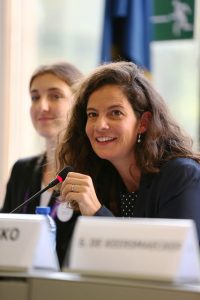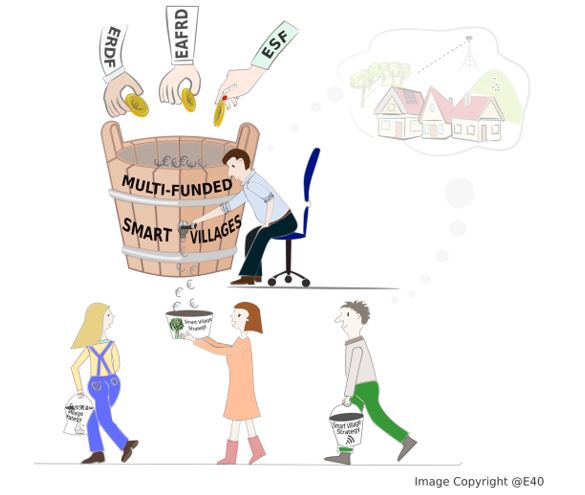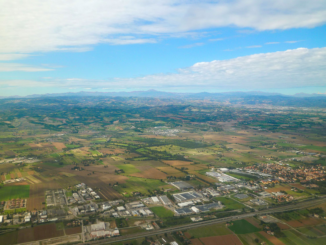By Edina Ocsko, Smart Village Network
This article contributes to the Rural Dialogues on ‘Smart Villages’. We argue that the current definition of ‘Smart Villages’ and guidance on its implementation do not provide sufficient explanation on how smart villages are different from and add value to existing initiatives and policy tools. We believe that we need a novel smart villages policy framework that adapts to the needs of villages, rather than villages needing to adapt to existing policy instruments. Therefore, we propose practical steps to develop policies in support of multi-funded integrated smart village strategies that can help ensuring a real added value of the ‘Smart Villages’ concept.
The Story so far from a different angle…
The ‘Smart Villages’ concept was initiated top-down, without a precise definition at the beginning and little consideration about how it would add value to or complement existing policy tools and approaches. The nice-sounding ‘smart villages’ concept originated from Members of the European Parliament and has quickly found its way into EU political discussions through the formal support of the European Commission and three Commissioners.
Defining what ‘Smart Villages’ exactly are only became a concern once the concept had already enjoyed strong political support at the EU level. However, “sewing the jacket to the button” has proven to be a challenging task, and – even after several attempts to provide a definition, guidance and clarification at the EU level – the ‘Smart Villages’ concept still raises more questions than answers.
“Sewing the jacket to the (Smart Villages) button” has proven to be a challenging task.
Rural Dialogues | Smart Villages – Turning Momentum into Support for Local Action
Do we really understand what the added value of ‘Smart Villages’ is?
The work of the ENRD Thematic Group over the past year has led to a series of recommendations about ‘what to avoid’ when developing smart villages, namely to avoid (i) over-defining Smart Villages, (ii) making digital technologies a precondition, and (iii) duplicating existing strategies and structures.
The Smart Village Network – an independent bottom-up open network of villages, village groups and village associations established in 2018 – has made similar recommendations through the SVN blog already in March 2018 on how to define smart villages:
• It argued that “We need a definition that allows all villages to (be)come smart” and what ‘smart’ is will much depend on the specific social, economic and environmental context of the village (including its basic characteristics & challenges as well as assets & opportunities).
• The same article argued that ‘smartness’ should not be linked to digital (and other) preconditions in order to avoid excluding certain villages that otherwise might have innovative and relevant solutions to rural challenges (i.e. definitions need to be inclusive and flexible).
A year after publishing our article on the Smart Village Network blog, a draft EU definition of smart villages has been developed that “is deliberately broad and inclusive” . The ENRD Thematic Group discussions also identified that we should “avoid over-defining smart villages” and “‘criteria’ for smart villages need to be flexible and adapted to the specific and individual context of villages” .
Current guidance does not explain satisfyingly how the ‘Smart Villages’ concept adds value to existing policy instruments.
However, current guidance still does not explain satisfyingly how the ‘Smart Villages’ concept is different from and adds value to existing policy instruments. The ENRD also concedes that the ‘what to avoid’ recommendations of its Thematic Group do not sufficiently clarify how smart villages add value: “So, if there is no precise definition of Smart Villages, they are not exclusively digital and they should not duplicate strategies or structures, how do we avoid the concept of Smart Villages becoming so general that it becomes almost meaningless?”
We should avoid reinventing the wheel
The Smart Village Network has organised meetings with the participation of its village members and also presented its views at external local stakeholder events. Our experience has been that people acting on the ground are highly interested in the new ‘Smart Villages’ movement and are eager to make the most use of it for their local communities. However, there is still a lack of clarity among them about how smart villages are different from things that they are doing already. LEADER Local Action Groups are particularly struggling to understand how the ‘Smart Villages’ approach adds value to their ‘business as usual’. Most importantly, both the villages concerned and national policy-makers are craving practical advice and concrete suggestions on what they need to do next and differently to contribute to the emergence of smart villages.
Practical lessons from multi-funded CLLD could help us move one step closer to the successful planning and implementation of smart villages.
The answers and guidance provided to date are not sufficient. For instance, the ENRD Thematic Group’s discussions conclude that one needs to “design and adapt a toolkit of interventions from the different funds”: We have known for some time that multi-funded and integrated approaches to local development are crucial policy instruments. Many countries experimented already at the beginning of this programming period with designing and implementing multi-funded Community-led Local Development (CLLD); see for instance LEADER LAG Survey 2017 (ENRD), LAG Funding). It is essential that we now consider why genuine multi-funded approaches have not become widespread and what policy-makers and local stakeholders have most struggled with. It is the practical lessons learned that could help us move one step closer to the successful planning and implementation of smart villages.
The specific fields identified by the ENRD Thematic Group in which the concept of Smart Villages can add value to existing tools are generic; see Paul Soto & Enrique Nieto: Rural Dialogues (2017). One risks reinventing the wheel by saying that ‘smart villages’ add value by (1) developing strategies that are “based on a local vision for structural change”, (2)“supporting collective action to respond to a specific local challenge or opportunity” driven (3) “locally by cooperation between civil society and public, private partnership”, and (4) “providing faster and more flexible support to rural communities for collective innovation”.
Many would argue that such values and concepts are not new at all in rural development (for instance, the same principles and concepts have driven LEADER LAGs and EIP Operational Groups for many years.) and we need to be more concrete on how smart villages should be planned and implemented in future rural development policies.
We have a smart village button … what should the jacket look like?
We do not claim to have found the “philosopher’s stone”. However, the Smart Village Network believes that ‘smart villages’ is a unique new policy opportunity that we can seize only if we can step out of our comfort zones, reflect on past experiences critically and provide practical recommendations that help us move forward.
Villages and village representatives should be much more engaged in EU and national-level smart villages policy design.
Firstly, we believe that – in the spirit of collective action – villages and village representatives should be much more engaged in EU and national-level smart villages policy design, beyond selected demonstration cases. Exchanging about demonstration cases is very important but not sufficient for engaging villages. Demonstration cases currently include the ENRD project examples through searching by ‘smart village’ and best practices and case studies developed by the Smart Eco-social Villages study that are not yet available publicly. Giving a voice to villages in policy-making as well as enabling exchange among them (including using innovative digital platforms) have been core missions of the Smart Village Network from the start (see our article of April 2018 on “Villages need to have a say on what smart villages are” as well as the Smart Village Network Declaration). Awareness-raising among villages about the new opportunities has been limited and villages have not been sufficiently engaged in the process.
Secondly, we believe that a key to the success of smart villages implementation will be a genuine multi-funded approach where single smart village strategies are supported by multiple funds.
A key to the success of smart villages implementation will be a genuine multi-funded approach.
While LEADER is a crucial instrument, LEADER/ CLLD funding in itself is not sufficient to reach a real breakthrough in addressing current rural challenges. The main added value of the ‘Smart Villages’ concept lies in its potential to mobilise multiple funding sources for integrated rural development.
In our blog article on ‘How to make smart villages happen?’ of April 2019 we shared our thoughts on what practical steps need to be taken at different levels to implement a multi-funded and integrated policy framework to support ‘smart villages’. In the blog article we argue that villages need incentives to adopt smart village strategies or start labelling existing projects, strategies and other instruments as ‘smart’. Without a clear support framework and policy instruments they will just carry on with their business as usual.
Managing Authorities of various funds and programmes should get together as soon as possible.
Therefore, managing authorities of various funds and programmes at national and regional levels should get together (e.g. in the form of a smart village ‘task force’) as soon as possible and start coordinating with each other the design of a supportive policy environment. As the ENRD also suggests (see Paul Soto & Enrique Nieto: Rural Dialogues (2017)), strengthening linkages of rural communities with urban and regional development is important. Relevant stakeholders representing these sectors and relevant policy instruments would also need to be engaged in the discussions on smart village policies, to ensure an integrated approach.
In line with the partnership principle, villages, village groups (including LAGs), village associations and their representatives need to be directly engaged in the process of designing future programmes and policies. The European Commission should live up to its promise and guide and support any Member State that is willing to experiment with a genuine multi-funded smart village support framework.
The smart villages (pilot) funding should be poured into a single ‘pot’ so that village beneficiaries do not need to think which fund they are applying for.
In an ideal scenario, portions of different funds should be specifically devoted to support smart village strategies. This could be done through a pilot approach, setting aside only a relatively small proportion of the relevant funds in an experimental way. This smart village (pilot) funding should be poured into a single ‘pot’ so that smart village beneficiaries do not need to think which fund they are applying for and what specific rules apply. The ‘demarcation and coordination of funds’ should not be the concern of the villages, but should be ensured through effective coordination of managing authorities (or intermediary bodies) in administering the ‘pot’ of smart village funds.
However, putting on paper such recommendations will not be sufficient for seizing the smart villages opportunity. The Smart Village Network has already started developing joint initiatives with its members to contribute to the design of practical smart village policy frameworks in specific local and national contexts. We will be happy to share future lessons from these actions for the benefit of the wider smart village community.

The contents of this article do not necessarily express the opinions of all the members of the Smart Village Network.
Edina Ocsko is founder and director of the E40 group. Edina has been working with EU-funded European projects for more than 15 years in the fields of rural, social and economic development.
She has worked for UK LEADER+ and the ENRD (European Network for Rural Devleopment) Contact Point, including as
More on Rural Dialogues
Rural Dialogues | Stochastic System Collapse Part 2 – the Social and Solidarity Economy Alternative
Rural Dialogues | Smart Villages – Turning Momentum into Support for Local Action
Rural Dialogues | Peasants of Nature – French Initiative Reconciles Agriculture & Biodiversity
Rural Dialogues | Landcare Germany – Bringing Farmers, Conservationists & Policymakers Together
Rural Dialogues | Best Immigration Practice can help Alleviate Rural Depopulation
Rural Dialogues | What are the 3 A’s of Feeding Ourselves in Ireland?
Rural Dialogues | Radical Old Ideas Gaining Ground in New Rural America
Rural Dialogues | Transition Presents an Unprecedented Opportunity for Rural Revival








